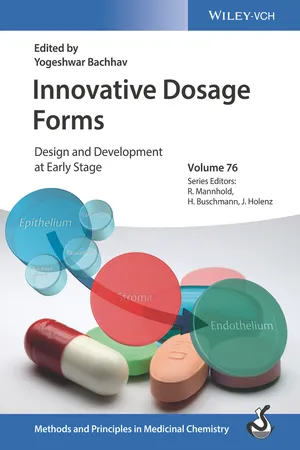
Innovative Dosage Forms
Design and Development at Early Stage
- English
- ePUB (mobile friendly)
- Available on iOS & Android
Innovative Dosage Forms
Design and Development at Early Stage
About This Book
Teaches future and current drug developers the latest innovations in drug formulation design and optimization This highly accessible, practice-oriented book examines current approaches in the development of drug formulations for preclinical and clinical studies, including the use of functional excipients to enhance solubility and stability. It covers oral, intravenous, topical, and parenteral administration routes. The book also discusses safety aspects of drugs and excipients, as well as regulatory issues relevant to formulation. Innovative Dosage Forms: Design and Development at Early Stage starts with a look at the impact of the polymorphic form of drugs on the preformulation and formulation development. It then offers readers reliable strategies for the formulation development of poorly soluble drugs. The book also studies the role of reactive impurities from the excipients on the formulation shelf life; preclinical formulation assessment of new chemical entities; and regulatory aspects for formulation design. Other chapters cover innovative formulations for special indications, including oncology injectables, delayed release and depot formulations; accessing pharmacokinetics of various dosage forms; physical characterization techniques to assess amorphous nature; novel formulations for protein oral dosage; and more. -Provides information that is essential for the drug development effort
-Presents the latest advances in the field and describes in detail innovative formulations, such as nanosuspensions, micelles, and cocrystals
-Describes current approaches in early pre-formulation to achieve the best in vivo results
-Addresses regulatory and safety aspects, which are key considerations for pharmaceutical companies
-Includes case studies from recent drug development programs to illustrate the practical challenges of preformulation design Innovative Dosage Forms: Design and Development at Early Stage provides valuable benefits to interdisciplinary drug discovery teams working in industry and academia and will appeal to medicinal chemists, pharmaceutical chemists, and pharmacologists.
Frequently asked questions
Information
1
Impact of the Polymorphic Form of Drugs/NCEs on Preformulation and Formulation Development
1.1 Introduction
| Source | Number of single NCEs | Polymorphism occurrence (%) |
| CSD | 5941 | 37 |
| European Pharmacopeia 2004 | 598 | 42 |
| Roche | 68 | 53 |
| Lilly | 68 | 66 |
1.1.1 Background
1.1.2 Types of Polymorphism
1.1.2.1 Conformational Polymorphism
Table of contents
- Cover
- Table of Contents
- Preface
- 1 Impact of the Polymorphic Form of Drugs/NCEs on Preformulation and Formulation Development
- 2 Strategies for the Formulation Development of Poorly Soluble Drugs via Oral Route
- 3 Effect of Residual Reactive Impurities in Excipients on the Stability of Pharmaceutical Products
- 4 Preclinical Formulation Assessment of NCEs
- 5 Regulatory Aspects for Formulation Design – with Focus on the Solid State
- 6 Insight into Innovative Applications of Parenteral Formulations
- 7 Assessing Pharmacokinetics of Various Dosage Forms at Early Stage
- 8 Transdermal Medical Devices: Formulation Aspects
- 9 Physical Characterization Techniques to Access Amorphous Nature
- 10 Design and Development of Ocular Formulations for Preclinical and Clinical Trials
- 11 Preclinical Safety Aspects for Excipients: Oral, IV, and Topical Routes
- 12 Formulation of Therapeutic Proteins: Strategies for Developing Oral Protein Formulations
- Index
- End User License Agreement